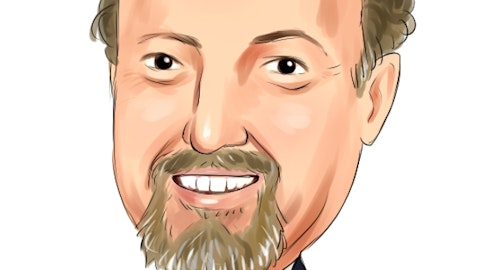Sterling Auty: Yes. Thanks. Hi, guys. You touched a little bit on my question in the last answer, but I just want to dive deeper and better understand the traction. What’s driving the traction you’re seeing in your observability solutions? How much of it is maturation in the light step functionality and what you’ve built on top of it? How much of it might just be price and what you’re able to bundle together as a platform?
CJ Desai: Yes. So I would say, overall, I put, including observability, all that in the ITOM umbrella, right? You can point out a cloud observability that our life step team has done well, and they had an amazing win with a very large fintech company, where we are going to actually displace an incumbent that does metrics and tracing. And we beat all the top competitors to win that deal in Q1. This is an example. But overall, when I look at ITOM, and that deals with the cloud estate, whether it’s private or public cloud, and as customers, our joint customers with hyperscalers are trying to optimize that cloud spend or expand, we are the right workflow platform when it comes to the workloads that are running in those clouds.
And with ITOM specifically, we saw that our grow and enterprise adoption has actually increased, including higher selling volume in Q1 of this year. In addition to that, our cloud discovery that happens via ITOM with Azure, AWS, GCP is also on the rise with a number of customers using those capabilities.
Bill McDermott: And Sterling, the one build I would give on this, just for you to know, Microsoft and ServiceNow understand each other and have like-minded ways of going to market and including not just geographically but in industry. So as CJ said, this Australian government agency we’re referring to is one example. But then you can go to South Africa, and you would see us doing something very interesting for an insurance provider, where we also displaced an aging legacy system. So we’re on the front end of innovation by industry and geo, and we really have common goals and shared values around making these customers successful, and we both know how to do it.
Sterling Auty: Understood. Thank you.
Bill McDermott: Thank you very much.
Operator: Our next question comes from the line of Tyler Radke from Citi. Please proceed.
Tyler Radke: Yes. Thank you for taking the question. Gina, just as we look at the updated guidance for the full year, I’m wondering if you could just walk us through some of the assumptions both on the subscription revenue side and margin side. It looked like you did beat by more than – you’re raising the full year guide if you account for currency. So just wondering if there’s any extra conservatism or moving pieces. And then the same thing on margins, there was strong outperformance this quarter. Thank you.
Gina Mastantuono: Yes. Tyler, thanks for the question. So we did raise the full year revenue guide by FX, and we did raise it slightly about $4 million for our fees. But given the current macro uncertainty and given that we’re only at the end of Q1; we wanted to remain prudent in our guide for the full year, which shouldn’t be surprising to you. There’s many, many years that we haven’t really raised in Q1 with such a big portion of the year still to go. So it’s really about being prudent in the current uncertainty more so than anything else. We feel really good about the beat in Q1 and our guide. While prudent to reflect the current macro, I think still should send a strong signal to our investors on the durability and strength of the Now Platform.
Tyler Radke: Yes. Makes sense. Thank you.
Gina Mastantuono: Thanks, Tyler.
Operator: Our next question comes from the line of Brad Zelnick from Deutsche Bank. Please proceed.
Brad Zelnick: Great, thank you so much and I’ll echo my congrats on a strong start to the year. For Bill or Gina, I’ve been getting a lot of questions on your net new ACV growth for last year, which was disclosed in your proxy as 14%. And considering the backdrop and tough prior year compare, it seems very healthy to me. But what factors should we consider in bridging to your $16 billion-plus target, which impacts close to mid-20s compounded growth? And how would you characterize the company’s net new ACV target for this year?
Gina Mastantuono: Yes, Brad. Great question. So yes, net new ACV growth in 2022 given the current macro and backdrop is very healthy given that environment. We’ve talked about the fact that the current macro as well as the FX movement would likely weigh on that guide for 2024 and 2026. What I can tell you and what I’m excited about is to make sure you come to Financial Analyst Day in May, where we’ll be really focused on the longer-term strategy as well as updating those relative numbers for you. And so we don’t guide for net new ACV, as you know, but we will give a lot of clarity as to what we’re thinking for the mid- and longer term at FAD in just next month. So look forward to seeing you there.
Brad Zelnick: Awesome. Always good to see you even better in Vegas. Thank you.
Gina Mastantuono: Thanks, Brad.
Bill McDermott: Thanks, Brad.
Operator: Our next question comes from the line of Karl Keirstead from UBS. Please proceed.
Karl Keirstead: Hi, thank you. Maybe this one for Gina. Gina, on the call three months ago, when you were asked about the shape of the cRPO trajectory throughout the year, you guided to a deceleration throughout calendar 2023. Just given that you outperformed in Q1, and conversely, the 2Q cRPO guide is a little bit below expectations, is that still the right framework to think about the second half? Thanks so much.
Gina Mastantuono: Yes. I mean, listen, Karl, I think that given the current macro, deceleration is very normal and expected, but you’ll continue to see us really driving strong demand across the board. And so we absolutely think that demand remains robust and strong, and we will continue to perform. But yes, given the current macro vis-à-vis last year, we’ll definitely see a little bit of deceleration throughout the year.
Karl Keirstead: Got it. Thanks, Gina.
Operator: Our next question comes from the line of Raimo Lenschow from Barclays. Please proceed.
Raimo Lenschow: Thank you. One quick question on the platform side. So that’s the one product area that really kind of gained and relative share for you guys this quarter. What are you seeing in terms of platform adoption out there? Because there’s obviously a lot of like system of record guys that have a platform, they have the stand-alone local guys that kind of want to be a platform. And then you are guys but you seem to be getting share. Is that kind of a function of in the downturn or in tougher times, you have a consolidation to the core strategic ventures that’s playing out there? Or is this more a longer-term theme? Thank you.
CJ Desai: Listen, we are, first of all Raimo, super pleased with our creator workflow performance that has many aspects to it. But the key aspect it is, of course, our low-code engine and our automation technologies. This platform, as you described it, you’re 100% right that there are many companies even with point solutions that market themselves as a platform company. We are truly a platform company. And when we sell creator workflows, that is sometimes used to extend our out-of-box applications. And sometimes, as Bill mentioned, customers use to create many, many new applications to digitize their processes. That business in itself is a very nice business that has been growing significantly over the last three to four years, and I feel very optimistic on that.
And the reason I feel optimistic versus point solutions that you described or a system of record because you cannot have all these applications being developed randomly without governance. Our key buyer tends to be IT organization. We serve IT organization. We have governance features on how you develop these apps, where does the data reside. And when we say that to our customers, they say, we would rather use your platform to create new applications than a point solution or from a system of record that only has a system of record data. And the second thing that’s really working for our platform is we organically build our integration or automation engine that not only integrates with all the 600-, 700-plus applications out there in the world, but allows you to automate any processes via RPA, machine learning and many new AI technologies that we are going to deliver.
I am extremely optimistic and bullish on this aspect of our platform, a creator workforce.





